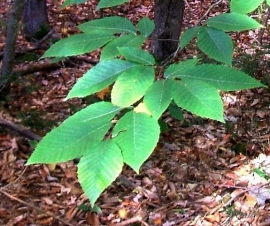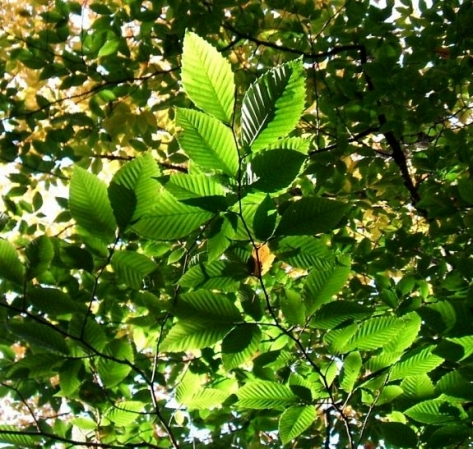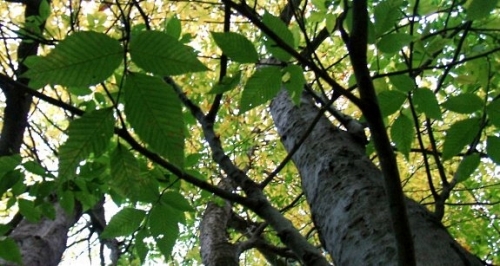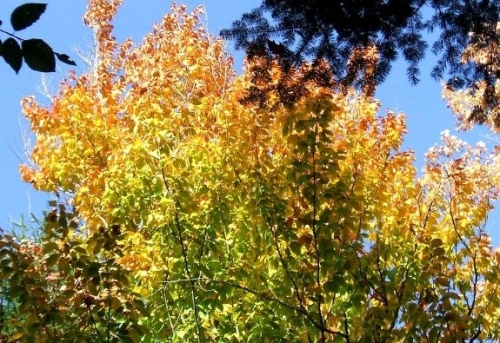Six years ago a first-time visitor to Balsamea — call him Schmoe — looked at a young beech tree in the yard (then just a campsite) and asked, “What’s that doing there?”

This is the tree Schmoe asked about. At the time it was about half this size.
His tone seemed to imply that there was something wrong with it being there — or something wrong with me for having it there.
I told him it was a beech tree that I saved when I cleared all the other original trees from that little part of the forest. (This was during my Thoreauvian Experiment, living off-grid in a 100 square foot camper for two years, with a dog, before Balsamea grew a house in 2010. I had cleared only a small space in the woods, less than a tenth of an acre.)
Other examples of American Beech:


I kept that tree because it had a nice shape, as opposed to so many other trees growing scraggly in our dense, competitive woods. When allowed to grow in the open, beeches have a beautiful shape and make terrific shade trees and climbing trees, and they produce spectacular autumn colors that last long after all the maples go bare.
When clearing space, I kept a lot of trees that were in bad shape, too. I nursed them along and they are wonderful now. In truth they were always wonderful. I just imposed my aesthetic notions on them, with the help of lopping shears.
Before I got to tell Schmoe why I kept that beech tree, or why I liked it, he added, “It’s a junk tree. They get that bark rust.”

The “bark rust” starts with an insect infestation which causes a fungal infection. Other than this bark condition, everything about this big old beach (one of our tallest) seems normal, and has been this way for at least 9 years that I know of.
.

Every day of the year I walk past that yellowy bit of junk (center) at least once, and I never tire of looking at it, with or without leaves, in any season. I’ve looked at it (except when it was buried in snow) every day since it was knee-high, when I preserved it (along with Schmoe’s mentioned above) after clearing what had been a very dense mix of trees there. It’s a happy little piece of junk.
I am keeping an open mind to the possibility that I could be entirely wrong in how I view trees, and beech in particular. Maybe they are junk trees and I just don’t get it. But an open mind is a terrible thing to waste, isn’t it?
I didn’t respond to his junk tree assessment (because of my open mindedness?). We went on walking. It was his first and last visit to Balsamea. I’m glad.
This case of people “assessing” my landscaping prowess wasn’t as odd as the newly and barely acquainted (by email only) woman — call her Schmoette — who scolded me for killing the wild blackberry briars trying to take over my yard and succeeding too far because I had not tried to do anything about them for four years since the house was built. I don’t like killing pollinator attracting plants. I even mow around wildflower patches. But I can’t let these briars that started since the house construction make me regret building the house.
This was the day after she told me that she hates milkweed and kills it in her yard.

Trees make me want to keep looking up.
When she said it, I didn’t tell her not to kill her milkweed. Never even hinted at it. I don’t know the circumstances she faces. Maybe they are interfering with something more important than strange opinions like “junk tree.” She didn’t say. And I’ve got this bad habit of sacrificing an open mind.
I just mentioned politely that it’s the only place monarch butterflies lay their eggs, and the monarchs are on the verge of getting official endangered species status. She said she didn’t care. She hates it and kills it.
The next day I commiserated regarding my blackberry briars. She freaked out (my interpretation of the term EEEEK!!! peppered throughout her email message) when I said that I kill invasive, fast-growing, fruitfully unproductive, damaging briars — which I feel bad about because their flowers are good for pollinators. She acted as if I’d said I was shooting monarch butterflies with the dog as a backstop.
So I sent a very gentle (really, it was downright loving) reply explaining why I felt I had no choice but to get the briars under control.
I never heard from her again. I don’t know why. Do you suppose she felt too embarrassed? Maybe it was that final sentence in my message, “One person’s blackberry is another person’s milkweed.” I thought it was cutely magnanimous. Don’t you?
I am so thankful that I live where the tree-to-human ratio is so marvelously high.

Now back to that bark rust business (sample above, but that’s not why I took that picture — I just liked what I saw when I looked up — I didn’t even notice the “rust” until now). First I want to report that while almost all American Beech in the Northeast US (and probably elsewhere) have this disease, they live decades with it, reproducing all the while. They have varying degrees of resistance, too. Balsamea has several big old beeches that have little or no infection.
We’re not going to beat this epidemic. It’s endemic. It’s just part of being beech. Like having bad eyes, skin, teeth, attitude and hollow mind are just parts of being me. Doesn’t make me unlovable junk, does it? (Shut up.)
Countless rusted beeches live to be fat, beautiful giants. People can’t live with cancer anywhere near as long as beech lives with bark rust. There are many crusty rusty sick junk beech here that are older than me and will be here long after me. And long after they die, for many years they will continue contributing a lot more to the planet than I will, or have, or could.

Keep looking up.

A dead tree isn’t dead. It’s just not making food any more. It retired to a simpler life. Long before it decomposes, its wood can be put to use for an endless life in furniture and other things, or it can be fuel.
A piece of wood that can still be fuel still has life. It is the life in the wood that gives life to the fire.
When it starts falling apart and becoming not wood, then it’s dead, and it transforms into something else that gives life to other things. Trees give even when they are not trees.
To what will I give life after I rot? Let there be hope: bury me shallow in the ground, deep in the woods. Or just drop my carcass into the middle of Taylor Pond, where it’s 90 feet deep, with a sack of rocks tied to my ankle. Nobody will know if you do it on a Wednesday off-season, or at 7 AM on Veteran’s Day (my favorite holiday because they made it for me). And don’t waste my good blue suit on it. Give that to the Salvation Army thrift shop. I don’t think polyester is biodegradable anyway. I have a long cotton nightshirt.
Above: One of my favorite old beech trees. It needs the help of red maple lipstick to be pretty, such junk as it is. Well … maybe not. That view without red may be the best one, no? Notice the branch structure. Often I look up there and see myself perched, eight years old. Trees may be a kind of anti-aging medicine. Often I see other children, ones who will live here in the future. I tend the trees for them, too. If I can live here long enough to pay off the mortgage, Balsamea will be left to the town as a park, or to an organization as a youth nature retreat and campground, maybe 4H or Scouts.
It scares me sometimes, or in a way almost torments me, to experience Balsamea in the ways I do and then suddenly realize, in a moment of heart-arresting mental choking, “Uh! I hold title to this place!” How the hell did that happen? It can’t be. But it is. So say the tears.
There is no gratitude befitting grace, only awe.

Big old happy triple-trunk beech at the Turkeyfoot campsite.

May 13, 2012 – The triple-trunk from a distance. Covered firewood pile in front.
It’s interesting to see how big old sick trees survive long after they are too homely to have in the front yard. Sorta like people that way. Schmoe was no Robert Redford. I’ve never seen Schmoette, and that’s perfectly okay with me thank you.
My front yard is an asylum. I have a big beech tree there that is not doing so well, and if it starts dying, you will not find me cutting it down until every last bit of foliage is gone and none returns for at least year. Then it will bless me in the fireplace for a long, long time.
No doubt somebody will see it after it died and say, “What’s that doing there?”
Being a tree.
I have a close relationship with the trees of Balsamea, so I notice when big old iconic masters of earth get sick or die. I enjoy watching the architectural wonders of what goes on for years and years after they die. I enjoy a big old snag. Many other critters do, too. It’s good to have an old snag to love.

I don’t think more than a handful of old beech — out of hundreds of mature ones here, among triple that many young ones — have died during my nine-year tenure as The Balsamean.
We have some happily living ones that I believe are over a hundred years old, with trunks two feet wide. One of them conveniently sits just inside a property boundary corner. It could die today and still be a great place to nail Posted signs twenty years from now.

They grow quickly and abundantly from both seeds and root sprouts. I pluck them off roots in the trails by the dozens every year.
Despite the junk-status-rendering horror of bark rust, they like living here, and they usually don’t get the rust until well into maturity. They are a staple of the environment here. To call them a junk tree is just ridiculous.



Even gray birch, which I tend to see as a “weedy” kind of tree, does not deserve to be called a junk tree. Its short life, small size, and fast decomposition (of the wood, not the bark, which outlasts the wood) makes it one of our most prolific topsoil builders. And its bark, like most birch, is a great fire starter.
I would not plant a gray birch in the yard, but I have one that got started naturally before I decided to clear the little space beyond it, so I’m letting it grow as an experiment to see how it does out in the open. Almost every specie of tree here fares better out in the open, but is also shade tolerant when young.

Rust or not, beech is a valuable tree. Its wood is strong and hard, understandable for a close cousin of oak. Its branch structure is more horizontal than many trees, making even young ones good shade trees, and older ones excellent climbing trees.
If I had the nerve to cut down a lot of them, or if my financial situation eventually requires (the trend is iffy), I could make some money selling beech fuel for wood stoves and outdoor boilers. The guy across the street would snatch it up. He was happy to get a truckload of storm-ravaged poplar along my road frontage, free for the asking. I could stack loads of poplar for sale along with beech.

Beech nuts are an important food source for several kinds of critters. The nuts don’t come every year. A few years ago we had millions of them. Since then, none. But they’ll be back, and the red squirrels will toss them down on me as I walk by.

I suppose you’ve noticed American beech has magnificent fall colors. There’s a hint in the species name, Fagus grandifolia, Latin grandi (great) + folia (leaves). Apparently Fagus just means beech. They and our red oak retain their leaves longer into autumn than all other tree species here.

Many of our beech — usually only the young ones, especially ones protected from strong wind exposure — retain their dry, papery, tan leaves all winter.
The books say that deer don’t eat beech buds. Well, I have proof that at least one deer stripped a five-foot beech that I was nursing along in a nice open space in the middle of a place I call Maple Square. I rarely see beech buds taken by deer, but I see far too many oak destroyed by them.

![]() I could go on for a long time (as if I haven’t already) about the interesting and enjoyable things about one of our most abundant and pleasing Balsameans, the American Beech. But I’ll spare you.
I could go on for a long time (as if I haven’t already) about the interesting and enjoyable things about one of our most abundant and pleasing Balsameans, the American Beech. But I’ll spare you.
If you really like one of these pictures, drop me a line and I can share the original, full size image for your not-for-profit website or blog dedicated to forest life, living, or loving.
Junk tree. Sheesh. Humans are the funniest animals.
Suggested reading:
- More from The Balsamean:
- American Beech in Autumn, Balsamea Style – a short post with nice pictures from Oct ’13
- And from the prior autumn, Going Beech Nuts – a short piece on beech nut frustration
- Autumn Light and Color – More leafing around in Fall 2012. Just some pretty pictures. No wordplay.
- Even better stuff elsewhere:
- A good concise report on Beech Bark Disease by Mary Holland, author of Naturally Curious, Milkweed Visitors, The Beaver’s Busy Year and Ferdinand Fox’s First Summer.
- A comprehensive professional report on the natural history of the American Beech, by the Morgan Arboretum of McGill University in Quebec.
- In his dazzling post Forest Gold – American Beech, Nick the field naturalist, photographer, and retired professor emeritus in the Environmental Science department at Morrisville State College in central New York reveals his passion for not just Fagus, but the whole Fagaceae family (including oaks). If you thought I had a few nice beech pictures, you ain’t seen nothin’ until you click this one.
- If you like beech, or any trees, you don’t want to miss this master bonsai maker’s instructions on Creating a Beech Forest Bonsai.
- I love Mary Anne Borge’s post Nutritious Fall Foliage: What makes leaves so colorful? … but especially her beech photos at Alexauken Wildlife Management Area, West Amwell, New Jersey and Haul Road at the Trapp Family Lodge, Stowe, Vermont.
- If that’s not enough …
- The Science of Color in Autumn Leaves by The United States National Arboretum
